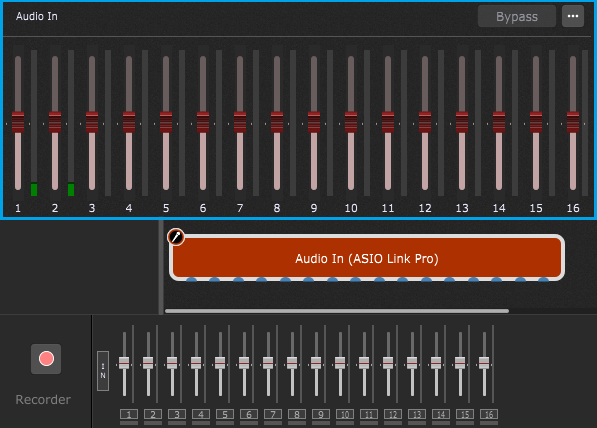The Audio In plugin represents the current connected physical interface used to receive audio or a virtual device, aggregating two or more physical interfaces (depending on your operating system):

Each plugin port represents one audio input. The actual number of these ports is a function of the capabilities of the interface connected to your system. For example, in the screenshot above, 16 ports are shown.
Double-clicking on the Audio In plugin opens its editor window, as indicated with the blue rectangle. You can adjust input levels by moving the corresponding sliders. The number of sliders matches the number of input ports. Moving any of these sliders will automatically update the corresponding slider in the bottom toolbar, and vice-versa.
However, as a matter of course, we encourage you to not adjust your levels through these global controls. It is usually better to insert Gain Controls or Audio Mixers into the Wiring view. The global input and output levels are really intended for emergency adjustments should you have a problem with FoH audio.
Note: when you create a new gig, this plugin is present by default in the Wiring view and cannot be removed from the design surface. However, you can specify different audio interfaces for Audio In. Navigate to Options -> Audio Setup to configure your audio interfaces.
Tip: if you need to change the selected interface or even the buffer size or sample rate, open or create an empty gig file first and change the audio interface there. This will be much faster as Gig Performer will not have to reset and possibly reload all your plugins. Further, some plugins don't "like" having their buffer size or sample rate changed after being loaded and may consequently crash when receiving such a request.
Audio In parameters
The following parameters are available for the Audio In plugin:
•Number of channels - allows you to get the current number of audio input channels.
•Input Gain (Channel #) - allows you to control the input gain for each input channel available.
•Input Level (Channel #) - allows you to display the input level for each input channel available (use with meter widgets).
•Overall Input Level - allows you to display the overall input level for all channels (use with meter widgets).
•Channel # Muting - mutes the specific channel (# represents the number of the channel).
Note: not all parameters are suitable for the widget control. Parameters such as Number of channels are suited for GPScript or OSC applications. Using scripting it can be determined how many channels the Audio In plugin offers and then the result can be used for other functions. Using OSC, you can e.g. create the exact number of VU-meters dynamically (if your OSC application supports this feature).